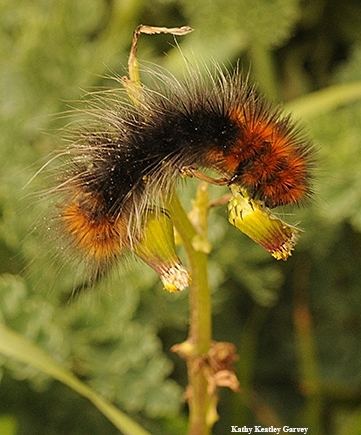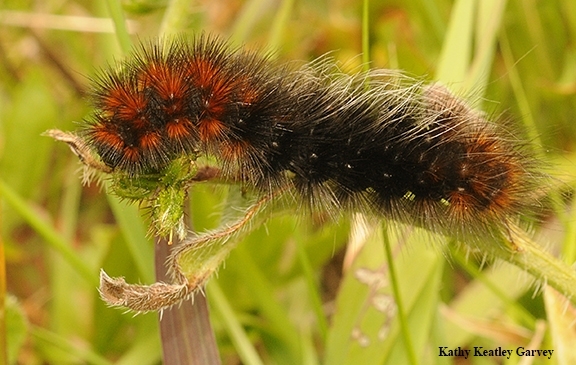
Let's hear it from the insects, namely the woolly bear caterpillars that populate the cliffs of Bodega Bay.
They may know.
A UC Davis ecologist and his lab who study woolly bear caterpillars, the immature form of the Ranchman's Tiger Moth, Platyprepia virginalis, think that the "bears" will again predict the winner, as they have for the past three decades.
The woolly bears feed primarily on lupine along the cliffs of Bodega Bay, says professor Richard "Rick" Karban of the UC Davis Department of Entomology and Nematology. Sometimes the population booms; other times, it's a bust. When the population thrives, a Democrat heads to the White House. When the population dives, the Republicans take over.
The UC Davis scientists, known for their expertise in plant-insect interactions, are now making national headlines with their political predictions.
“The pollsters and talking heads seem unable to size up this election cycle,” said Karban. “Paul the Octopus had a pretty good run predicting soccer matches in 2012 so perhaps the woolly bears have earned as much credibility at forecasting this presidential election.”
“The woollies aren't seemingly as decided as they have been in years past - I don't know what they are really predicting,” said graduate student Eric LoPresti. “They seem to be leaning Republican but the point is between the range that we've seen in the past for each party.”

Washington Post reporter Karin Bruilliard picked it up and ran with it on April 26 in a piece titled, “These Fuzzy Little Caterpillars Are Better at Predicting Elections Than Most Pundits.”

This year, however, the pollster findings are unclear, they agreed. “Given their wildly erroneous predictions thus far for both primaries, trusting their predictions for the general election seems ill-advised,” LoPresti wrote. “The woolly bears, on the other hand, have a 100% accurate prediction record over the past 30 years. In years of low abundance, a Republican is elected, and in years of high abundance, a Democrat.”
“A superficial examination suggests that 2016 will be a Republican year – woolly bear abundance is not particularly high,” LoPresti noted. “However, looking a little closer, it may not be. The number of woolly bears per lupine bush in 2016 (0.53) is higher than the average Republican year by 152% and is 36% above the highest Republican year ever recorded (1988). However, it is only 27% of an average Democratic year and still only 36% of the lowest Democratic year (2008). This result is without presidential precedent in the last 30 years.”
So, which party, which political animal (elephant or the donkey), will occupy the White House come Jan. 1, 2017? What do the bears indicate?
“We suspect that the Republicans have the edge,” the UC Davis scientists surmised. “However, a valid hypothesis would be a third-party winner, such as a right-leaning independent (a logical placeholder in between Democrats and Republicans). Perhaps Donald Trump will take particular interest in our data. Alternately, a contested Republican convention could produce a fractured party and the old Republican woolly bear average would not accurately represent the mean caterpillar abundances seen by this new party.”
Responding to the April 25 blog, someone noticed the resemblance of the hair of a presidential candidate to the hair of the woolly bear caterpillar.
The UC Davis scientists study the caterpillars at the Bodega Marine Reserve above the Bodega Marine Laboratory. The reserve, which surrounds the Bodega Marine Laboratory, is a unit of the University of California Natural Reserve System and is administered by UC Davis.
“Platyprepia virginalis caterpillars are dietary generalists and feed on multiple host species within a single day,” Karban says.
In research, Diet Mixing Enhances the Performance of a Generalist Caterpillar, Platyprepia virginalis, published in February 2010 in the journal Ecological Entomology, “We found that relative growth rates and rates of survival were higher when they fed on mixed diets compared to lupine only,” Karban said. These results were consistent with hypotheses that mixed diets provided balanced nutrition, diluted toxins, and/or allowed recovery from parasitoids, although our data did not allow us to separate these non-exclusive explanations.”
The caterpillar's taste for plants containing alkaloids may help it survive parasitoids, Karban said.
Attached Images:
